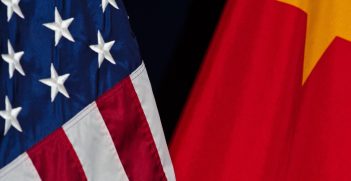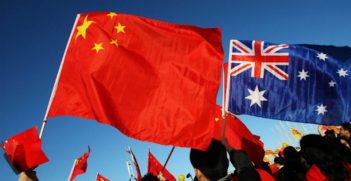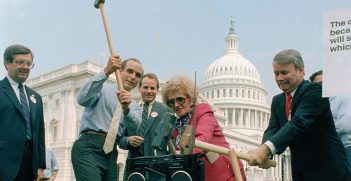New and Improved TPP with Eastern Leadership

With the signing of the updated Trans-Pacific Partnership agreement imminent and American leadership absent, who has taken the helm? The future of the region’s trade landscape is at stake.
President Donald Trump was elected with a self-serving trade policy as a key election platform and he has stuck to it. He argues this will resuscitate manufacturing in the US and pressure trading partners to alter trade balances so the US is in surplus.
He does not—or does not want to—understand that success in trade does not require surpluses; or that trade in services and investment in today‘s world is becoming more important than trade in goods. The latter is already the case for industrialised economies.
This change is occurring in Australia. Bringing foreign students and tourists into Australia is equivalent to exporting education and tourism services. They now constitute 20 per cent of our exports. Mining is Australia’s most important export sector, led by iron ore and coal. Services contribute around 20 per cent of the cost of extraction and transport of mineral products. In most industrialised economies, services generate 70 to 80 per cent of gross domestic product (GDP). In developing economies services contribute just 40 to 60 per cent of GDP because they are protected. Trade agreements are needed that encourage trade in services and investment to generate growth.
The Trans-Pacific Partnership (TPP) is the most advanced trade agreement yet negotiated, principally because it commits growing Asia-Pacific economies to open services and investment markets, not just reducing tariffs. It is the foundation for the prospect of an Asia-Pacific free trade area which has been on the APEC drawing board for two decades and which the TPP is regarded as a stepping stone towards.
The TPP was led by the US. This leadership sought to shape a common system to foster growth and economic interdependence in the Asia-Pacific region. President Obama announced it as such with Julia Gillard and it was one of the most important free trade agreements considered by the US. President Trump walked away because of his antediluvian view of what an effective trade system looks like.
As fate would have it, Japan’s Prime Minster Shinzo Abe found himself in a position to lead where Trump would not. Apprehension among Japanese voters about China’s strategic positioning, particularly in the South China Sea, returned Abe to office with record majority. It was enough to override protectionist interests in Japan, which for decades restricted Japan from actively engaging in trade liberalisation.
Abe lead the resuscitation of the TPP (now dubbed the Comprehensive and Progressive Trans-Pacific Partnership—the CPTPP—to satisfy Canadian interests) with active support and encouragement from Canberra. Prime Minister Malcolm Turnbull, Minister for Trade, Steven Ciobo, and senior Department of Foreign Affairs and Trade staff played key roles supporting Tokyo’s strategy. Japan is now positioned where it should always have been, as a leading force in promoting economic integration in the Asia Pacific.
There has been the inevitable domestic criticism of the new agreement. Opposition leader Bill Shorten has so far refused to endorse it (although Senator Penny Wong favoured it when she was shadow trade minister) and the Australian Council of Trade Union (ACTU) has criticised it, demanding that entry of temporary workers should be prevented. Until recently, the Australian Labor Party had been a leading party promoting free trade. Opening Australia’s markets and reducing expensive protectionist measures was a legacy of Bob Hawke. The conservative John Howard followed that path.
The growth and the economic efficiency fostered by this liberalisation has made Australian the most successful industrialised economy, measured as the record holder for continuing economic growth among all industrialised economies. That has been the benefit of free trade policy.
Australia’s first comprehensive free trade agreement was negotiated with the United States. It came into effect in 2005. It was an agreement of the new era. Liberalisation of services and investment were the most important features. It also includes a commitment within a few years to substantially open the US beef market. Currently Australian beef exports to the US are limited to hamburger meat. Criticisms of that free trade agreement (FTA) differ little from the criticism today of the CPTPP. Polling then showed 70 per cent of Australians supported the US FTA. Rates of approval of recent FTAs with South Korea, Japan and China are similar.
Many of the objections to the CPTPP are virtually the same as those to the earlier FTAs. Basically it amounts to opposition to competition. A new complaint is that the economic impact of the agreement was not properly assessed before the government agreed to it. The TPP has been on the table for several months. While full details are available, few critiques have been made. The Washington-based Petersen Institute, one of the leading trade policy centres in the US, has assessed the TPP as generating positive gains for Australia.
There is a case for government to bring businesses with important interests into discussions on a confidential basis on measures under consideration in negotiations. But there is no case to invite any party claiming a direct interest if its primary interest is disapproval in principle of free trade agreements.
Despite Trump’s opposition to the TPP (and many other trade agreements), other regional economies recognise the CPTPP is the beginning of a broader trend to build more open markets in the Asia-Pacific. The Philippines and South Korea have already indicated they want to join the CPTPP.
Alan Oxley is chair of the APEC Study Centre at RMIT University and Principal of ITS Global.
This article is published under a Creative Commons Licence and may be republished with attribution.





